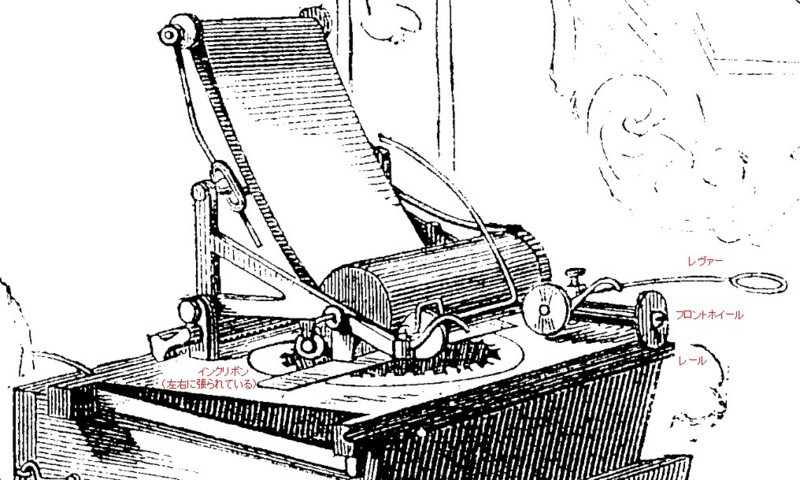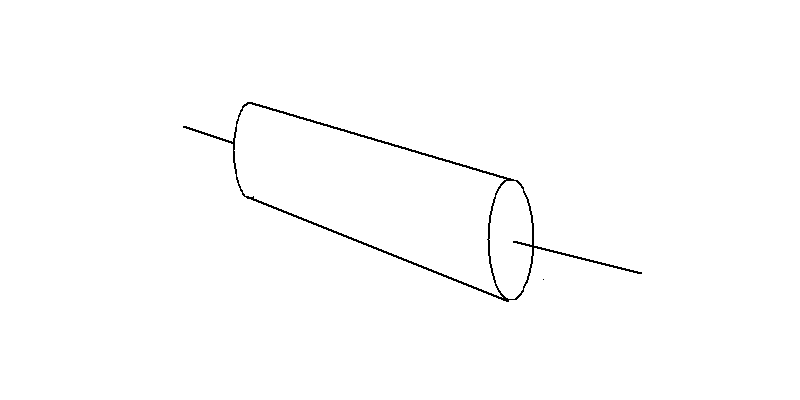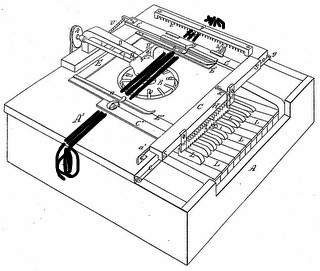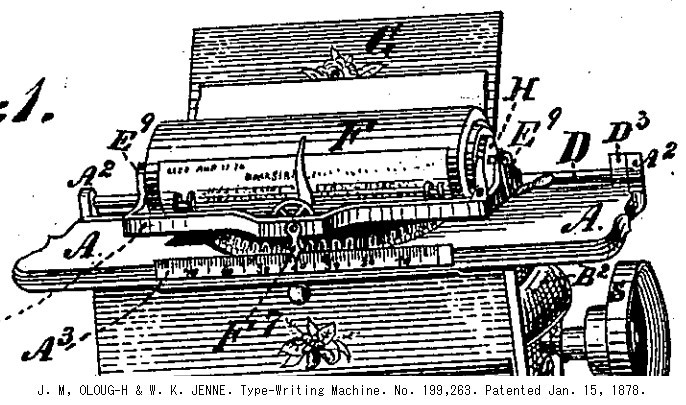- In the drawings, A represents a type-writer key-lever, generally made of a strip Of wood,
- the finger-key stem d. may be metal.
- The finger-key D is made of a bottom metallic disk,
It's no need to read here with but if you've read "The Truth" ever, fortunately.. raycy-jp sometimes in Japanese or
5/27/2011
wooden key-levers., and metalized key-top and finger-key stem.
5/22/2011
It might be caused by carriage jump but in different.

It might be caused by carriage jump but in a different way we now see.And the far-left "A" just looks like the carriage jumped the margin when it was returned.
~Alan
Yahoo! Groups
The days when Sholes penciled "Is this paper thick enough?" and just ahead when he had typed out this letter to Densmore on October maybe18th, 1869,,

In those days, it seems they didn't have side moving roller carriage in longitude along the line out-printing mechanism.(Later they had as on Scientific American August 10th 1872.)




The mechanism they had a patent as cylindrical platen earlier was for moving in circumferential direction along the circular out-printing on the rotating cylindrical platen,
not for longitudal direction line printing.
http://qwerty-history.g.hatena.ne.jp/raycy/20110522/1306030896
And to roll up the cardboard might be hard to bend to set on the platen.
http://raycy-jp.blogspot.com/2011/05/18-inch-isnt-paper-too-thick-enough-to.html
Sholes typed a letter to Densmore. Oct.
eight inch thick cardboard Sholes Densmore - Google book search28 is not be accurate, and might be18, 1869, on cardboard an eighth of an inch thick, and added a penciled note in which he triumphantly asked, " Is this paper thick enough?
So I guess the carriage jump might happen on an old model machine which made over adding with mechanism changed to like ink-ribbon winding in downward, or so.

But I should know more detail how paper had attached round on the cylindorical platen on these days of Sholes.

http://qwerty-history.g.hatena.ne.jp/raycy/20110523/1306120502
5/21/2011
If 1/8-inch! Is the paper too thick enough to roll along platen?
Sholes typed a letter to Densmore. Oct.
eight inch thick cardboard Sholes Densmore - Google book search28 is not be accurate, and might be18, 1869, on cardboard an eighth of an inch thick, and added a penciled note in which he triumphantly asked, " Is this paper thick enough?
APKY(Associate Professor Koichi Yasuoka) might think in a book(cf. Koichi Yasuoka and Motoko Yasuoka: Myth of QWERTY Keyboard, NTT Publishing, Tokyo (2008)):
- the letter on Oct. 18th 1870 was typed on a similar model of machine of the patent No.118491 by Sholes,
- with the paper attached roll-up around on the platen, .
- (or the cardboard put as flat and weighed by the roller
but this is funny cause the roller could run around only in one way..
I guess another alternative possibility:
Sholes might just only change the setting way of ink-ribbon rolled-downward, on old-type-machine, for testing..
and set the ink-ribbon under the surface of cardboard that Sholes typed at.

5/20/2011
Some words seem left on a paper, of Clough or Jenne..
http://kygaku.g.hatena.ne.jp/raycy/20110519/1305742330They've got digitized noise, and lost details of the original when google? degitezed.
If you could reach the analogue data of the drawings..
Are they some message that Clough or Jenne left? or so nothing?
5/17/2011
Mr. Schwalbach's gift of some porcelains to Wisconsin Historical Society
http://groups.yahoo.com/group/TYPEWRITERS/message/49455I'm sure it should not be appropriate, but,,
it has several keys missing
If it were affordable for before S&G, some might be in Wisconsin Historical Society, once were of belongings of Mathias Schwalbach.
http://babel.hathitrust.org/cgi/pt/search?id=uc1.%24b728168&view=&q1=%22porcelain+keys%22
http://kygaku.g.hatena.ne.jp/raycy/20110517/1305591172
> several keys missing- the Q, )0, and left shift.
Dear JD :)
http://babel.hathitrust.org/cgi/pt/search?id=njp.32101064987959&view=image&q1=%22Dear+Jack%3A+%29%22
http://kygaku.g.hatena.ne.jp/raycy/20110508/1304804022
~rj
5/16/2011
It hears that Schwalbach had done the four-bank keyboard and handed it to Sholes around the spring of 1871.
http://groups.yahoo.com/group/TYPEWRITERS/message/49446The saying of Schwalbach hears as follows:
I have a quick question about some terminology I've heard. I've heard some
machines referred to as 1, 2, 3, or 4 bank machines--what exactly does this
mean?
http://content.wisconsinhistory.org/cdm4/document.php?CISOROOT=%2Fwmh&CISOPTR=17986&REC=0&CISOBOX=four-bank
p.398
his criticisms annoyed sholes but impelled him to go on making improvements the inventor soon adopted a new keyboard of Schwalbach's devising which consisted of four rows of metal key levers and buttons set in ascending banks.[18]
[18] Schwalbach afterwards said that " while he continued to work for Mr. Sholes for $3.00 a day during the winter of 1870 he took up the work independently in his home he worked out the four-bank key board and in the spring of 1871 he laid his completed model before messrs sholes and glidden howard in typewriter topics 3:8
Matthias? double TT? W(^O^)V (T-T) (。>_<)
http://yasuoka.blogspot.com/2011/04/but-unique-and-lasting-feature-of.htmlIn "On the Prehistory of QWERTY(OPQ)"(Mar. 2011), they write 'Matthias Schwalbach.'
Koichi Yasuoka and Motoko Yasuoka: "On the Prehistory of QWERTY", ZINBUN, No.42 (March 2011), pp.161-174).
("Matthias"|マチアス)(Schwalbach|シュバル) ("Koichi Yasuoka"|"Yasuoka Koichi"|"KoichiYasuoka"|安岡孝一) -raycy - Google Search:
Current(2001, might also be in1977,) writes 'Mathias.'
(First Illinois paperback,2001. CC.© 1977 by Richard Nelson Current. Reprinted by arrangement with the author)
Matthias Schwalbach inauthor:Current - Google Search:
5/09/2011
wooden key-levers,,
Henry's attic: some fascinating gifts to Henry Ford and his museum
by: Ford Richardson Bryan,Sarah Evans
The Remington desk typewriter shown here, manufactured sometime between 1874 and 1876, has an enclosed case, wooden key levers, a lage wooden platen, and a ribbon wound on wooden spools as wide as the platen.
The Remington Rand Laboratories of Ilion gave the typewriter to Henry Ford. The date of the giftewas not recorded.
typewriter oil, sperm whale, black fish, porpoise..
Journal of the Society of Arts: v 42
Society of Arts (Great Britain) - 1894 -
In a well- made typewriter oil is scarcely ever required, if at all. The parts are so well fitted as to render its use quite unnecessary, and its presence is only likely to give trouble by the oil becoming sticky and collecting dust. Anything but the finest clock oil must be absolutely avoided if an operator desires to keep his machine in order, and it should only be used in the most sparing manner.
40 92 Nye Wm P New Bedford Mass Sewing machine watch and clock oils These oils are obtained from the head of the sperm whale the black fish and porpoise and most carefully refined for the purposes mentioned only during the severest cold of winter T 49 soi
5/08/2011
Re: Excuse me.. This is me who sent an opportunistic and mistakable message
http://groups.yahoo.com/group/TYPEWRITERS/message/49324
Which are we talking about (Type-bars or sub-levers)?
Are we talking about type-bars or sub-levers when making reference to early
Remington or Caligraph type-writers? Not sure I know of such a type-writer.
I believe most all very early Remington and Caligraph type-writers had metal
type-bars and wood sub-levers (something to do with alignment). It would
seem the wood type-bars would soon find themselves out of alignment and thus
would find themselves on a junk pile. Perhaps someone on the list knows of
such a machine. Check with DR.
Dax
Re: Excuse me.. This is me who sent and started additional an oppotunistic and mistakable confusing message
http://en.wikipedia.org/wiki/Honkadori
My reason why I had started another thread about the material of key-levers
: which is running underneath of the machine from front to rear
is, I think, this will help to make it clear when the four-bank keyboard had done among in the group of Sholes and Schwalbach and fellows.
There was an message
about typebar metal brass or something steel
I took after the message
Re:The wooden key-levers that ran front-to-rear underneath were of a fine-grain wood that had been painted black
http://groups.yahoo.com/group/TYPEWRITERS/message/49311
I gave my Caligraph away long ago, so I don't know how the keyboard was
arranged. The wooden key-levers that ran front-to-rear underneath were
of a fine-grain wood that had been painted black but most of the paint
had flaked off. The problem with using wood this way is that it would
fail much sooner than metal at the pivot points. But there was no sign
of rot or warping.
What wonderful key-levers of the writing machine running underneath of , hiding fine-gain behind the peint of black.. looks as if lacquered japan..Wow
If they were lacquerd japan, never had flaked off as long as Fukushima nuke was sound and healthy..
5/07/2011
Do you ride bicycle?
http://www.ascii-art.de/ascii/s/stickman.txt
Riding BICYCLES __o __o o __o ,__o o__, _ Y<_ -Y<, _/Y_> _`Y<,_ _-Y_<, ,>_/-_ (_)/(_) O / O O,> / O (*)/ (*) (*)/'(*) (*)`Y(*) o _ /<. (*)>(*)
タイプライターアート - 葉仮名raycy - KliologY:
"double up(ie..strike over each other : )" V(^e^)V nor skip ___/
Or only from carriage trouble..?
double up(ie..strike over each other : )
WRITING-MACHINES --- THEIR USE AND ABUSE, GENERAL REMARKS
It is only the invisible oil that lubricates and the surplus merely catches dust and clogs and retareis the action of the machinery causing the machine to run unnecessarily hard and the letters to "double up" or strike over each other giving rise to the belief that the tensions need altering
Barron "double up"
Remington of Wyckoff, Seamans & Benedict says "it does not double up nor skip"
HathiTrust Digital Library - Out West magazine v.12 1899-1900
Re:Wyckoff
http://groups.yahoo.com/group/TYPEWRITERS/message/49307
The article of "USE AND ABUSE.. (something)"[1] says similar thing as Wyckoff[2] says, but not colornized nor Irishush nor Jappipee nor so non..
ref.
[1]"WRITING-MACHINES --- THEIR USE AND ABUSE, GENERAL REMARKS", Munson's phonographic news and teacher. v. IV No.1. (1884)
[2]Wyckoff, W. O. (Nov. and Dec., 1883). “CARE OF THE TYPE-WRITER”. The Exponent Ⅰ: 225–227.A careful examination by a person with even little mechanical skill will usually disclose the trouble, which in nine cases out of ten will prove to be something other than the necessity for altering the tensions.
Munson's phonographic news - Google books:
http://babel.hathitrust.org/cgi/ptsearch?id=nyp.33433017210562&q1=Irishmen

